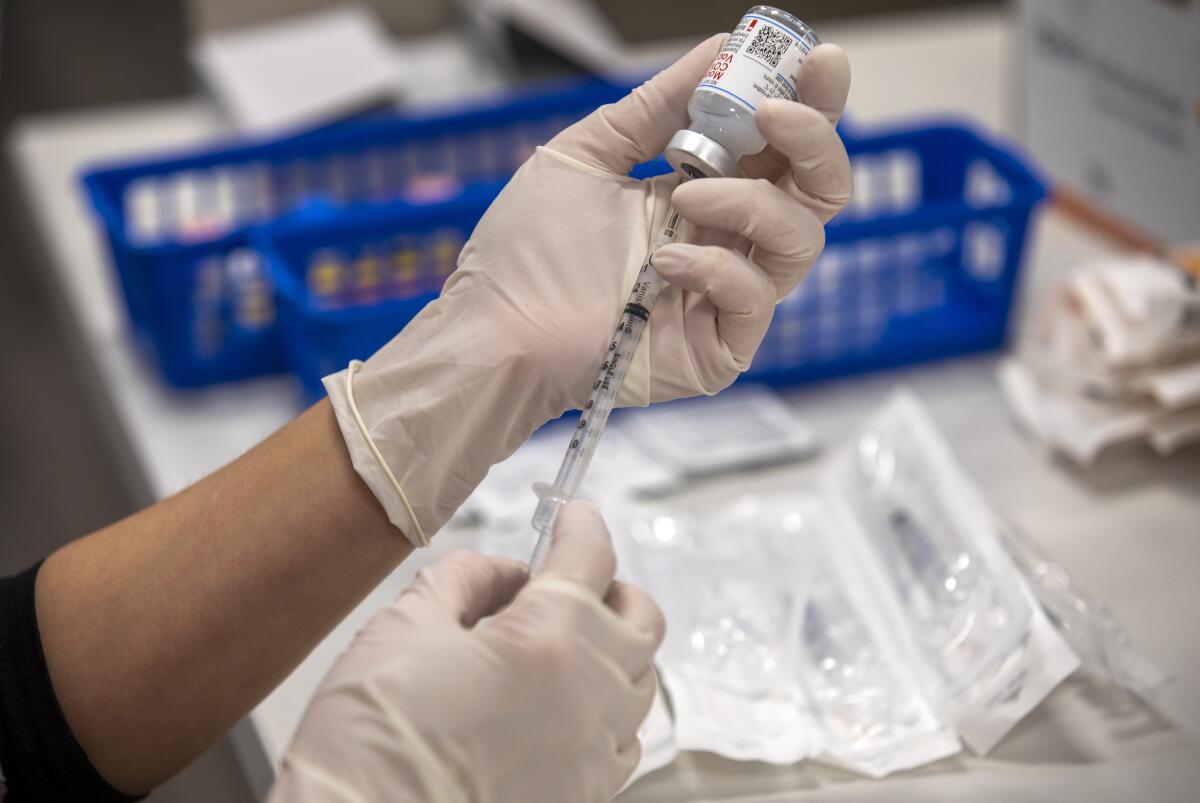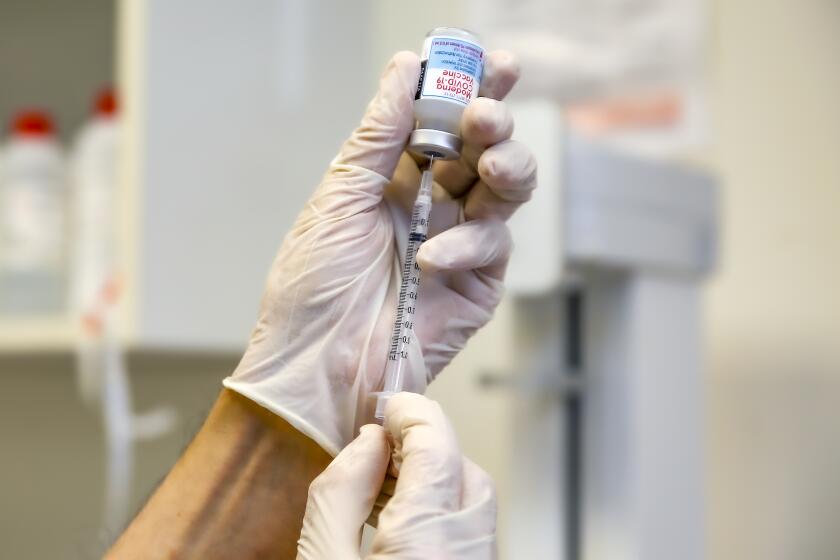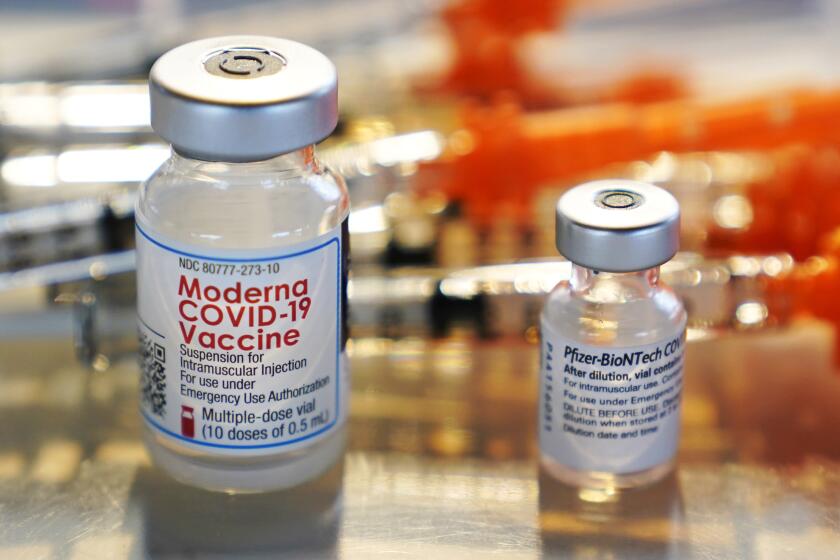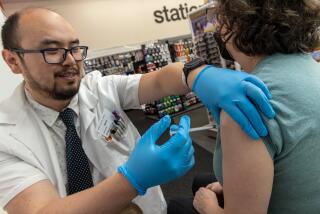When can I get my Omicron booster in California? Here’s what we know

After Labor Day, California health officials expect to quickly get to work on the next expansive phase of the COVID-19 vaccination campaign: distributing and administering newly authorized, Omicron-specific booster shots.
While there are still a few hurdles to clear before officials start doling out the doses, the expectation is that eligible residents will be able to roll up their sleeves come mid-September.
“Because vaccinations do remain our best defense against severe illness, we’re pleased to report that the updated Omicron vaccine boosters should be available very soon,” Los Angeles County Public Health Director Barbara Ferrer said Tuesday.
The L.A. County Department of Public Health has already pre-ordered its full initial allocation of about 170,000 doses of the Omicron booster.
The new U.S. boosters are combination shots, with half the original vaccine recipe and half protection against the most contagious Omicron versions.
The U.S. Food and Drug Administration Wednesday authorized the updated booster — a bivalent vaccine meant to target both the original coronavirus strain as well as the highly transmissible BA.4 and BA.5 Omicron subvariants. The authorization covers Pfizer’s Omicron booster for those age 12 and up, and Moderna’s booster for adults.
“The COVID-19 vaccines, including boosters, continue to save countless lives and prevent the most serious outcomes, hospitalization and death, of COVID-19,” FDA Commissioner Dr. Robert Califf said in a statement. “As we head into fall and begin to spend more time indoors, we strongly encourage anyone who is eligible to consider receiving a booster dose with a bivalent COVID-19 vaccine to provide better protection against currently circulating variants.”
The matter now goes to the U.S. Centers for Disease Control and Prevention, which will undergo its own process to determine recommendations for who should be eligible for the shots. The agency’s Advisory Committee on Immunization Practices is scheduled to meet Thursday morning and by that afternoon vote on recommendations to provide to CDC Director Dr. Rochelle Walensky.
Walensky’s decision would be the final step on the federal level that would allow the shots to go into arms.
There’s usually an additional step in California and several other Western states. The Western States Scientific Safety Review Workgroup — a coalition of public health experts from California, Nevada, Oregon and Washington — also independently reviews and signs off on new vaccine or booster offerings, typically within a day or two of federal action.
The pending arrival of an Omicron booster shot marks an ambitious new phase in the nation’s vaccination campaign before a possible new COVID surge.
Assuming the shots are green-lit this week, L.A. County expects to receive its first shipment of Omicron boosters between Sept. 6 and 9, Ferrer said. More than 300 different healthcare providers are preparing to administer the booster shot around mid-September, she added.
L.A. County plans to offer the booster at its seven community vaccination sites, five public health centers and hundreds of local vaccine clinics. People can search for vaccination sites at vaccinatelacounty.com.
While the original vaccines still do relatively well in keeping people out of the intensive care unit and dying, their effectiveness in preventing infection has declined over time because of the evolution of the Omicron strain.
BA.5, in particular, has proved to be not only highly transmissible but also able to reinfect those who recently got over a bout with a prior strain of the coronavirus. The CDC estimates that particular subvariant comprised 89% of coronavirus cases nationwide for the weeklong period that ended Saturday.
The updated boosters, which have been anticipated for months, are designed specifically to combat BA.5 as well as the less-common BA.4 Omicron subvariant.
At a recent forum, White House COVID-19 response coordinator Dr. Ashish Jha said the new booster represents a potentially substantial upgrade in the vaccine “in terms of their ability to prevent infection, to prevent transmission, certainly to prevent serious illness and death.”
With new COVID-19 boosters expected later this year, health experts urge Californians not to put off a first or second booster shot until then.
Generally, many officials and experts recommend getting a booster as soon as you’re eligible — particularly if you’re at higher risk of severe health consequences from COVID-19.
But others may decide to wait a bit, until October or November, as the booster’s potency will likely wane over time, as has been the case with other vaccine doses.
Peak effectiveness will likely be in the four or five months following the shot, with the maximum effectiveness one month after the injection, said Dr. Peter Chin-Hong, a UC San Francisco infectious disease expert.
In the pandemic’s first fall-and-winter wave, coronavirus cases in California began increasing in November and accelerated sharply in December. In last year’s fall-and-winter wave, cases began spiking in December.
For now, California seems headed into a relative lull in coronavirus transmission that has also been observed in past late summers and early autumns.
Coronavirus case rates are continuing to fall. For the seven-day period that ended Tuesday, the state reported an average of 8,119 new coronavirus cases per day, a decrease of 32% compared to two weeks ago, according to data compiled by The Times.
Over that same period, L.A. County reported about 2,700 coronavirus cases a day, down 16% from the prior week, and a decline of 60% from the summer peak of nearly 6,900 cases a day.
On a per capita basis, L.A. County as of Tuesday was reporting about 190 new cases a week for every 100,000 residents. A rate of 100 or more new cases for every 100,000 residents is considered high.
The last time the case rate was this low was in mid-May.
The weekly COVID-19 death toll remains elevated. For the seven-day period that ended Tuesday, L.A. County reported 101 deaths. That’s lower than this summer’s peak of 122 deaths, recorded between July 31 and Aug. 6, but higher than the prior week’s tally of 83 deaths.
Observed coronavirus levels in L.A. County’s wastewater are either flat or declining. The region did, however, recently see some very small increases in the number of new outbreaks at skilled nursing facilities and K-12 classrooms, the latter likely reflecting that more schools are resuming instruction.
The number of worksites reporting clusters of coronavirus cases has also increased slightly.
Health experts are noting that more people who are experiencing very mild illness are working anyway — exacerbating the coronavirus transmission risk.
Since Omicron’s initial fall-and-winter punch faded, California and the nation as a whole have been hit with a parade of increasingly infectious subvariants that fought each other for dominance. The late spring saw the emergence of BA.2 and BA.2.12.1, which transitioned directly into the summer season of BA.4 and BA.5 with no respite.
At the moment, though, there don’t appear to be any signs that another shoe is about to drop. Two newer subvariants, BA.4.6 and BA.2.75, have yet to outcompete BA.5 to any meaningful degree in Los Angeles County.
“There are no new subvariants or sub-lineages that appear likely to overtake BA.5 given the current pattern,” Ferrer said. “This is an encouraging sign, especially when viewed in light of our decreasing cases, and it may allow for further decline in transmission.”
Because all currently circulating subvariants have the ability of to reinfect people who have had COVID-19 earlier, Ferrer said she continued to recommend masking in indoor public settings, getting tested when ill and isolating at home when you have COVID-19, gathering outdoors instead of indoors, opening windows and turning on air filters when indoors, and taking rapid tests before gathering indoors and before and after travel.
“I do feel much better about where we are today than where we’ve been for quite a while,” Ferrer said. “Particularly this year ... we just moved very quickly from one variant to another without getting a real break. I think we’re getting a break now.”
More to Read
Start your day right
Sign up for Essential California for news, features and recommendations from the L.A. Times and beyond in your inbox six days a week.
You may occasionally receive promotional content from the Los Angeles Times.












